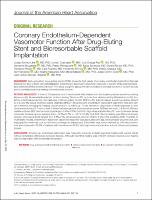| dc.contributor | Vall d'Hebron Barcelona Hospital Campus |
| dc.contributor.author | Gomez Lara, Josep |
| dc.contributor.author | Oyarzabal, Loreto |
| dc.contributor.author | Ortega-Paz, Luis |
| dc.contributor.author | Brugaletta, Salvatore |
| dc.contributor.author | Romaguera, Rafael |
| dc.contributor.author | Salvatella, Neus |
| dc.contributor.author | Otaegui Irurueta, Imanol |
| dc.date.accessioned | 2022-05-31T07:18:53Z |
| dc.date.available | 2022-05-31T07:18:53Z |
| dc.date.issued | 2021-11-16 |
| dc.identifier.citation | Gomez-Lara J, Oyarzabal L, Ortega-Paz L, Brugaletta S, Romaguera R, Salvatella N, et al. Coronary Endothelium-Dependent Vasomotor Function After Drug-Eluting Stent and Bioresorbable Scaffold Implantation. J Am Heart Assoc. 2021 Nov 16;10(22):e022123. |
| dc.identifier.issn | 2047-9980 |
| dc.identifier.uri | https://hdl.handle.net/11351/7590 |
| dc.description | Myocardial infarction; Endothelial dysfunction; Optical coherence tomography |
| dc.description.abstract | Background
Early generation drug‐eluting stents (DESs) showed a high grade of coronary endothelial dysfunction that was attributed to lack of stent reendothelialization. Endothelium‐dependent vasomotor response of current DESs and bioresorbable scaffolds (BRSs) remains unknown. This study sought to assess the device‐related endothelial function of current devices and to correlate neointima healing with endothelial function.
Methods and Results
A total of 206 patients from 4 randomized trials treated with the durable‐polymer everolimus‐eluting Xience (n=44), bioresorbable‐polymer sirolimus‐eluting Orsiro (n=35), polymer‐free biolimus‐eluting Biofreedom (n=24), bioactive endothelial‐progenitor cell‐capturing sirolimus‐eluting Combo DES (n=25), polymer‐based everolimus‐eluting Absorb (n=44), and Mg‐based sirolimus‐eluting Magmaris BRS (n=34) underwent endothelium‐dependent vasomotor tests and optical coherence tomography imaging, as per protocol, at follow‐up. Crude vasomotor responses of distal segments to low‐dose acetylcholine (10−6 mol/L) were different between groups: bioresorbablepolymer DEShad the worst (−8.4%±12.6%) and durable‐polymer DES had the most physiologic (−0.4%±11.8%; P=0.014). High‐dose acetylcholine (10−4 mol/L) showed similar responses between groups (ranging from −10.8%±11.6% to −18.1%±15.4%; P=0.229). Device healing was different between devices. Uncovered struts ranged from 6.3%±7.1% (bioresorbable‐polymer DES) to 2.5%±4.5% (bioactive DES; P=0.056). In multivariate models, endothelium‐dependent vasomotor response was associated with age, bioresorbable‐polymer DES, and angiographic lumen loss, but not with strut coverage nor plaque type. Endothelial dysfunction (defined as ≥4% vasoconstriction) was observed in 46.6% of patients with low‐dose and 68.9% with high‐dose acetylcholine, without differences between groups.
Conclusions
At follow‐up, endothelial dysfunction was frequently observed in distal segments treated with current stents without remarkable differences between devices. Although neointima healing was different between devices, poor healing was not associated with endothelial dysfunction. |
| dc.language.iso | eng |
| dc.publisher | Wiley |
| dc.relation.ispartofseries | Journal of the American Heart Association;10(22) |
| dc.rights | Attribution-NonCommercial 4.0 International |
| dc.rights.uri | http://creativecommons.org/licenses/by-nc/4.0/ |
| dc.source | Scientia |
| dc.subject | Cor - Malalties - Tractament |
| dc.subject | Medicaments - Alliberament retardat |
| dc.subject | Cor - Malalties - Cirurgia |
| dc.subject.mesh | Percutaneous Coronary Intervention |
| dc.subject.mesh | Drug-Eluting Stents |
| dc.subject.mesh | Coronary Disease |
| dc.title | Coronary Endothelium‐Dependent Vasomotor Function After Drug‐Eluting Stent and Bioresorbable Scaffold Implantation |
| dc.type | info:eu-repo/semantics/article |
| dc.identifier.doi | 10.1161/JAHA.121.022123 |
| dc.subject.decs | cirugía coronaria percutánea |
| dc.subject.decs | stents liberadores de fármacos |
| dc.subject.decs | enfermedad coronaria |
| dc.relation.publishversion | https://doi.org/10.1161/JAHA.121.022123 |
| dc.type.version | info:eu-repo/semantics/publishedVersion |
| dc.audience | Professionals |
| dc.contributor.organismes | Institut Català de la Salut |
| dc.contributor.authoraffiliation | [Gomez-Lara J, Romaguera R] University Hospital of Bellvitge, Biomedical Resarch Institute of Bellvitge (IDIBELL), University of Barcelona, L'Hospitalet de Llobregat, Spain. [Oyarzabal L] University Hospital of Bellvitge, Biomedical Resarch Institute of Bellvitge (IDIBELL), University of Barcelona, L'Hospitalet de Llobregat, Spain. Clinic Hospital of Barcelona, August Pi i Sunyer Biomedical Research Institute (IDIBAPS), Barcelona, Spain. [Ortega-Paz L, Brugaletta S] Clinic Hospital of Barcelona, August Pi i Sunyer Biomedical Research Institute (IDIBAPS), Barcelona, Spain. [Salvatella N] Heart Disease Reseacrh Group, Mar Hospital, Biomedical Research Institute of Mar Hospital (IMIM), Barcelona, Spain. [Otaegui I] Servei de Cardiologia, Vall d’Hebron Hospital Universitari, Barcelona, Spain |
| dc.identifier.pmid | 34729992 |
| dc.identifier.wos | 000718875100023 |
| dc.rights.accessrights | info:eu-repo/semantics/openAccess |


